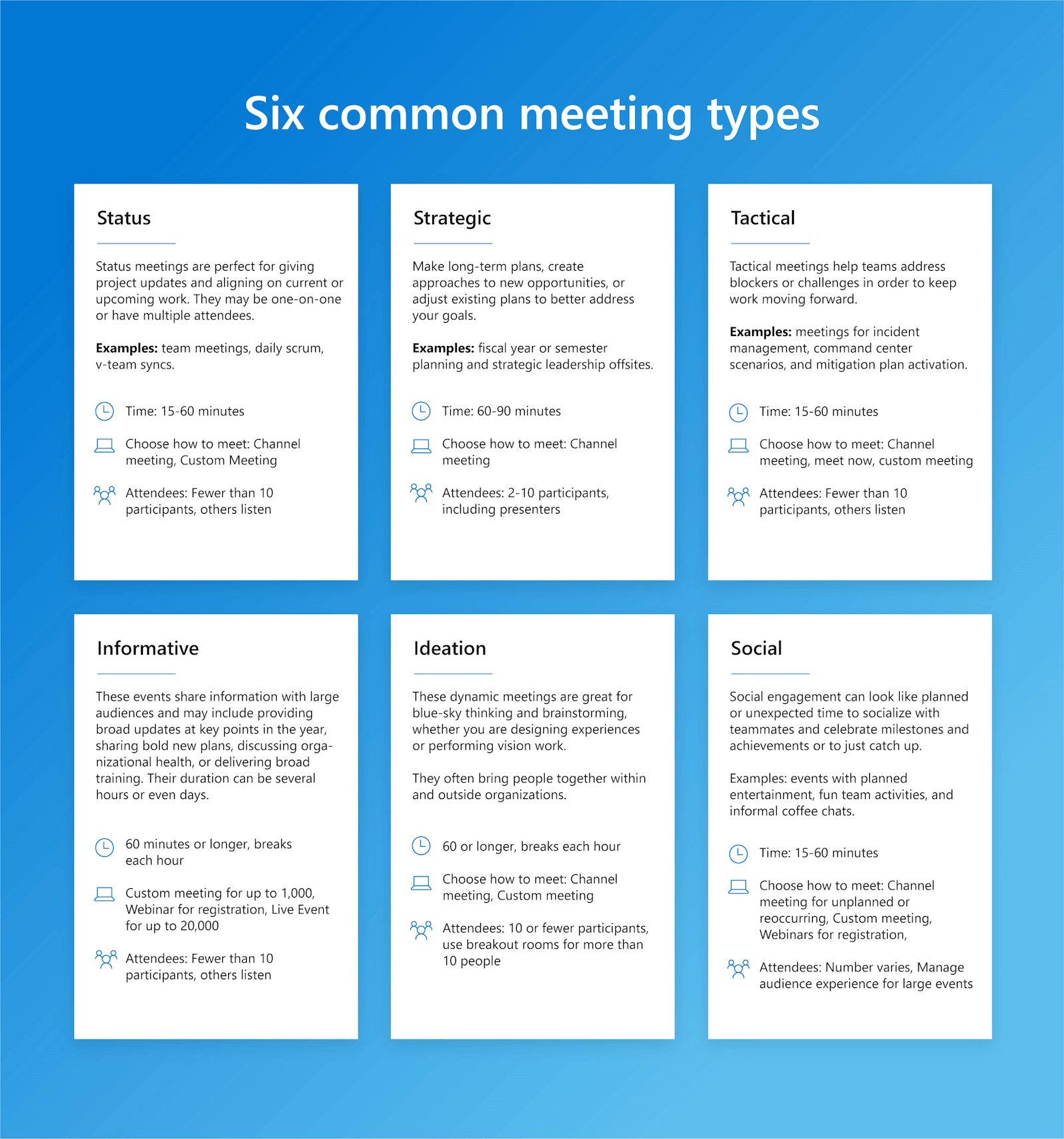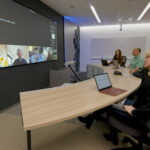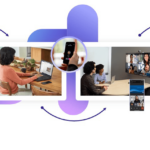 At Microsoft, we’re transforming the meeting experience to encourage collaboration and increase productivity.
At Microsoft, we’re transforming the meeting experience to encourage collaboration and increase productivity.
At the beginning of the COVID-19 pandemic, the shift to predominantly remote meetings inspired our Microsoft Digital Employee Experience (MDEE) team to examine what makes an effective meeting in which everyone feels included. We then used this research to develop the Microsoft Teams Meeting Guide, which is a Modern SharePoint site that’s available to all Microsoft employees. We’ve found this guide to be so useful that we’re inviting you to download the and repurpose it in your own Modern SharePoint site. We believe that this content can help evolve your company’s meetings, too.
Getting started
Imagine that all your meetings empower participation and meet the goals you’ve set. Imagine further that people attending your meetings know why they’re invited and how to prepare. Imagine still that your meetings encourage building collaboration and communication rather than result in fatigue. Our MDEE team is helping make these dreams a reality with the creation of the Microsoft Teams Meeting Guide.
We want to improve how Microsoft employees can achieve more together, helping improve collaboration and promote productivity for all of our employees.
To create the Microsoft Teams Meeting Guide, we worked with Microsoft Research and product groups to develop a research-based guide about how to run effective meetings. We’ve been using this engaging guide, built in Modern SharePoint, since March 2021, and have updated it regularly as new Microsoft Teams releases new features or best-practice guidance changes.
This blog post introduces research that led to the development of the Microsoft Teams Meeting Guide and how the guide’s use has helped Microsoft employees. NOTE: We’re providing visuals from the Microsoft Teams Meeting Guide as examples only.
Examining remote-meeting experiences
Before the onset of the COVID-19 pandemic, there usually were attendees who joined meetings remotely while others gathered in person. The remote attendees often found themselves inadvertently left out of conversations and, sometimes, even the meetings.
“The biggest challenge would be that most of the people there were in person and would start discussions, sometimes even before walking into the room,” says Ed Gonzalez, a curriculum manager on the Global CO+I/GOLD Learning & Development team at Microsoft. “They’d be involved in those discussions and, because of that, forget to start the meeting. And there’d be two or three of us just waiting and waiting, and so we missed a lot that way.”
The pandemic levelled the playing field, as suddenly everyone was attending meetings remotely. We saw this as an opportunity to examine and learn about the gaps and gains with respect to remote meetings. We then applied this learning to hybrid meetings, where there are both remote and in-person attendees. Our MDEE team researched what makes meetings inclusive and effective, using internal and external surveys, studies, and employee remarks.
Research conclusions
During our research, we discovered that inclusive meetings are at least three times more likely to be effective and that key elements that make meetings more inclusive include when you:
- Share an agenda.
- Begin and end meetings on time.
- Encourage attendees to use their video functionality.
- Make it clear who is in the meeting and why.
- Provide a pre-read for the meeting when you believe it applicable or helpful.
Developing the Microsoft Teams Meeting Guide

We developed the Microsoft Teams Meeting Guide to address the challenges we discovered during our research and encourage improvements in those areas. The guide is built on the Microsoft SharePoint Online platform as a site that every employee can access and leverage. It includes helpful guidance about:
- Starting meetings off right.
- Reducing meeting fatigue and increasing engagement for attendees.
- Deciding whether and how attendees should use video.
- Ensuring attendees have access to the correct information before, during, and after a meeting.
- Using Teams apps to enhance your meeting.
- Conducting hybrid meetings.
We want to clearly reveal the most impactful changes that you can make in meetings while encouraging site users to dig deeper into the topics and guidance so they can glean more insights.
“These are simple, thoughtful actions that can make a big difference in the feeling of being comfortable in a meeting, which allows for that inclusion and participation,” says Sara Bush, a principal program manager in MDEE.
The site supports this with its clean layout and the way in which it organizes information.
The Microsoft Teams Meeting Guide includes 10 key pages, including:
- A Home page that provides an overview and links to other important pages.
- Best practices that apply to all meetings at each phase: before the meeting, during the meeting, and after the meeting
- Information about each of the six common Microsoft meeting archetypes.
Promoting the meeting guide internally

The Microsoft Teams Meeting Guide is available to everyone at Microsoft, and we’re employing many strategies to ensure people know about it. Our promotional campaign includes quick bits of information about the guide and links to it, and tips and tricks. We’ve also developed and shared longer blogs, videos, and articles to drive interest in it, and have used forums such as Teams, Microsoft Yammer, and Microsoft’s internal IT help site, and newsletters and emails. We continue to release campaigns that coincide with new Microsoft Teams feature releases. Additionally, all new hires receive the Microsoft Teams Meeting Guide and managers are starting to include it in their onboarding materials.
Improving our meetings
Jacqueline Le, a senior business program manager in US Manufacturing, has shared the Microsoft Teams Meeting Guide with many of her colleagues, scheduling quick Microsoft Teams calls to share it, as she finds it’s a great way to encourage people to implement it. She said she especially appreciates the guidance about agendas, which she has leveraged to help her team decide how much time they need for a meeting.
“It’s relatively easy to use and navigate,” Le says. “You can scroll once and quickly assess what you want to get out of it. And then you can scroll again and get some more information. It’s not heavy reading, and it’s more visually appealing.”
Connor Joyce, a behavioral researcher for the Microsoft Viva Insights team, says the guide’s meeting archetypes enable him to pinpoint the type of meetings he needs to organize, which then helps him only invite the people that are most important to that meeting. This means he doesn’t invite people who aren’t required to achieve the meeting goals, thereby giving people their time back and helping reduce meeting fatigue and overload.
“If they really want to know (about the meeting), they can read the notes or watch the recording,” Joyce says. Thus, some employees are finding that the Microsoft Teams Meeting Guide is saving employees time, as they don’t have to attend some meetings and can review materials asynchronously.
Keeping current
We continue to update the Microsoft Teams Meeting Guide as Microsoft Teams features evolve to help people collaborate more effectively. We’ve been updating guidelines to support hybrid meetings based on our research and Microsoft Teams features that support them.
We’re providing you with the most recent Microsoft Teams Meeting Guide, and we recommend that you provide feedback channels for your own employees and enable them to customize it to meet their needs. You can track new Microsoft Teams features through the Microsoft 365 roadmap and Microsoft Teams help & learning pages.

We hope that you’ll customize and implement the Microsoft Teams Meeting Guide in a Modern SharePoint site that is available to your employees, as using it can help your employees save time and reduce meeting overload, use resources more efficiently, and collaborate more effectively with their teammates.

- Check out this story about the future of work.
- Read how Microsoft Employees are Using Avatars for Meetings.
- Review this guide to having better remote meetings by being more intentional.
Tags: digital transformation








